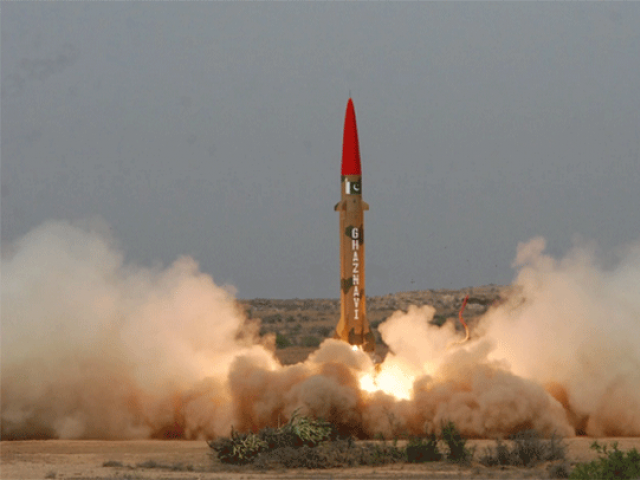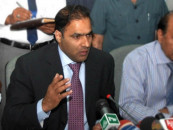Can India destroy Pakistan’s nuclear arsenal?
India will be facing an air force and army that has been in constant war for the last 15 years

India will be facing an air force and army that has been in constant war for the last 15 years. PHOTO: ISPR
"As far as IAF is concerned, it has the ability to locate, fix and strike and that is not only for tactical nuclear weapons but also for other targets across the border," he had said during the annual Air Force Day press conference on IAF response to Pakistan's store of tactical nuclear weapons.
The Indian air chief is not the only one to hurl such warnings and publicly acknowledge the existence of Cold Start doctrine (CSD). On January 4, India’s Chief of Army Staff Bipin Rawat made a similar hawkish claim.
Pakistan has better military industrial base than India: Indian VCOAS
Before dissecting the actual claim of the trigger-happy generals, it is worth noting that such statements cannot be random slips of the tongue but delivered with consent at the highest level, i.e. Narendra Modi’s outrage against CPEC and solidarity with militants in Balochistan. Sushma Swaraj parroted the same mantra at the UNGA last month. With an assortment of RSS ideologues and practitioners such as Ajit Doval, Sushma Swaraj and Manohar Parrikar (to name a few), the Modi government has to beat war drum against Pakistan to make up for its failings while stirring the religio-communal cord. Thus, there has not been a clarification on the generals’ remarks.
Indian Air Chief Marshal Dhanoa made a few tall claims with pretty interesting timing. Currently, the Indian finance ministry is discussing various budget proposals, which will be placed before the parliament in January. His statement came days after Pakistan-China concluded the Shaheen IV drills whose unique feature was joint sorties by PAF and PLAAF pilots in Su-27 and Su-30 jets, whose similar versions are IAF’s offensive platforms of choice.
In angry retort, India calls Pakistan ‘terror factory’
After the unveiling of surface-to-surface medium-range Ababeel ballistic missile and solid-fuelled Nasr tactical ballistic missile, strategists and analysts are questioning the efficacy of India’s Cold Start doctrine evermore. Understandably, the IAF chief’s press conference on Pakistan’s tactical nuclear weapons was aimed to publicly allay the widespread above-mentioned concerns.
Then comes the real question of India’s actual capability to locate and destroy Pakistan’s nuclear arsenal and other vital strategic assets. Has Delhi’s surveillance ability surpassed Washington’s during the 1991 Gulf War?
Despite throwing B-52s Tomahawk cruise missiles, the US could merely hit Scud storage areas and factories. Over 2,000 sorties and missile attacks failed to take out Iraq’s Scud mobile launchers. Thus, the tall claim of locating, fixing and destroy is trashed as nothing more than a shallow brag. India’s dream of 'Great Nasr Hunt' has quite many chinks to remedy.
Dhanoa may have forgotten that none of the 36 Rafale jets has been inducted. The first delivery is slated for November 2019 and the final sometime in second half of 2022. Yet, India plans to acquire 90 more state-of-the-art fighter jets until 2021. Meanwhile, the IAF strategic planners have to fix technical issues with Su-30MKIs. Assuming that China does not heat things up when India attacks Pakistan, its air force will not have a dearth of fighter jets. The scenario becomes trickier in the wake of two-front war. Pakistan’s 70 plus F-16s and over 100 JF-17s offer a matching response to the aggressors until the French fighter jets are inducted.
India’s missile arsenal is potent and poses a credible threat. However, the process of their activation and mobilisation can give away clues to watchful Pakistan and deny her the vital element of surprise. Islamabad’s LY-80 (or HQ-16) surface-to-air missile systems alongside shorter-range FM-90 SAMs will be the first to welcome any hostile object entering its airspace.
The increasingly belligerent posturing of India justifies Pakistan to reverse its decision of nuclear warheads from their delivery systems. The policy was adopted during Musharraf era as a confidence-building measure as part of Pakistan's cooperative nuclear diplomacy.
The Cold Start doctrine: real or fictional
In 2004, the Cold Start doctrine was envisaged and soon the word was out that relying on the mobilisation of smaller, more compact formation of conventional forces in a series of attack, India will invade and bleed Pakistan with the help of IAF. That is exactly the air marshal was hinting at in his presser.
The first principle is the element of strategic and tactical surprise while launching the attack while the being the push being so swift that the international community’s reaction comes after the desired gain in enemy territory. And, the third cornerstone is to use small captured areas of Pakistan using some eight ‘battle divisions’ numbering up to 50,000 troops from armoured and mechanised brigades. Delhi assumes that the entire campaign will be so rapid, confusing and lethal that Islamabad will not consider invoking its nuclear first-use choice.
India is building up the capability for German blitzkrieg-style attacks on the Pakistan soil and achieving the objectives within 96 hours. Besides, there are assumptions that Islamabad will not be able to mobilise its tactical arsenal well in time. Even if Pakistan manages to use short-range tactical weapons, they will be exploding on its own soil (which the IAF chief hopes to be neutralised in pre-emptive strikes).
India shifting focus of nuclear strategy from Pakistan to China
Psychological warfare through international, mainstream national and social media is integral to the doctrine. Already, the phenomenon of corporate-sector funded pro-India papers is evidently justifying its military ambition while maligning Pakistan.
Delhi’s military establishment supposes that before Pakistan will go all-out nuclear; the international community will intervene for a ceasefire.
Can Pakistan counter India’s military prowess?
The Indian air chief's fantasy is far from achieving at best achieving 50% success. Since tit-for-tat testing of its nuclear devices in 1998, Islamabad has been working with an utmost focus on second-strike capability (completing its tirade) besides refining its tactical nuclear warheads.
Under the National Command Authority (NCA), the procedures must have been fine-tuned, and drills for storage, assembly and launch are repeated over and over again.
Why will Pakistan not address India’s assumption about authorisation of tactical weapons’ use from crucial battlefronts? For a fact, the country never took India’s no-first-use policy on its face value. Since Modi took over, there has been repeated hint at India reversing its stated policy to nuclear first-use.
The Cold Start is akin to a Bollywood scenario where the hero achieves the impossible and returns unscathed in no time.
Supposing that India manages to keep its strategic surprise and General Bipin mobilises his brigades towards the international border, the first dampener will be the terrain itself. Except for strategically less attractive desert regions of southern Punjab and entire Sindh, there exists an assortment of natural geographical barriers to slow the hypothetical swift movement. The areas of significant strategic value in Jammu and Kashmir, as well as northern and central Punjab, limit little room for brisk offensive attack. From high mountains in Kashmir to a network of rivers, canals and bridge in northern Punjab ominously limit the advance. And, they are well guarded at all time, more so in the wake of the enemy’s hawkish posturing.
Musharraf says he had considered nuclear attack on India in 2002
India’s might have a larger number of troops but the majority is based in central parts contrary to Pakistan’s 80% divisions being adjacent to the international border, some of whom in defensive postures but forward-deployed.
Besides, tough terrain and India’s narrow and inefficient road network will further hamper its fancied swift march while Pakistan has developed a vast network of motorways and highways, which ease the mobilisation of heavy equipment and troops alike.
One of the key impediments for India is obsolete but large military hardware while Pakistan is much smaller but more recent and constantly updated.
From its tanks, armoured vehicles to artillery as munitions, everything is to be replaced. The soldier morale has been hit hard by draconian powers with officers to sack them as well as a feeling of being ignored when it comes to basic needs such food (ration) and health. For an offensive operation of the scale, being crowed the Indian military Cold Start doctrine pre-requisites magical mix of 30% cutting military hardware, 40% existing technology and 30% obsolete munitions. Its war stamina from supplies and logistical perspective is less than two weeks, 10 days to quote exactly from Indian estimates.
At the operational level too, India lacks 1.5 to 1 numerical superiority. Its divisions deployed along the Pakistani border are predominantly infantry with limited offensive capacity. Islamabad has been investing rightly in its mechanised infantry which gives its army sharp teeth to bite. Though BrahMos cruise missile range has been extended to 600 kilometres after joining Missile Technology Control Regime (MTCR), it is yet to be properly integrated into the force structure.
Pakistan and India — thermonuclear love
Dynamics of India’s quest for military reign
Dhanoa’s statement has not done India any favour unless proven through actions. At best, he has expressed frustration over enemy’s preparedness and resourcefulness despite limitations. His comments make catchy headlines in hyper-nationalist media and appeal to the Hindutva crowd.
The shrinking socialist opposition to India’s soaring military budget may get lesser attention than usual. The people would be taxed more in the budget ahead to continue funding the ludicrously costly military modernisation programme.
In the wake of any bravado by Bipin and Dhanoa, there are sure going to be many surprises, from strategy and tactics to technology.
South Asia observers have been noticing for long that Pakistan’s tests of a missile or other munitions follow India’s to maintain clarity about the balance of power. Thus, plausible it is that some weapons were never showed off or publicly tested or the range of missiles or capability of radars and fighter jets enhanced but with boasting about them.
Pakistan’s tactical strategists have been taking into account everything from doctrinal flaws to capability aspects as troop morale and training factors. India will be facing an air force and army that has been in constant war for the last 15 years. The war on terror has been a multidimensional war, ranging from intelligence-based raids to full-scale operations in diverse trains. Did it not offer the military to simulate counter-Cold Start inspired attacks?
It is too late now for India’s deep ambition to cull Pakistan’s nuclear weapons. Delhi’s dilemma lies somewhere between Ababeel MIRV and short-range Nasr missiles. Vajpayee started overt nuclearisation of South Asia and Modi is playing risky politics on it. As veteran South Asia watcher, Michael Krepon of the Stimson Centre said that embracing and upgrading of Pakistan’s tactical nuclear weapons is a consequence of “India’s growing conventional capabilities and its more proactive military plans.”
CPEC, the other thorn in India’s throat, is no less painful. Things might have been different if Delhi had benefited from the composite dialogue process than applying delaying tactics. Modi’s diplomatic blackmail or Bipin and Dhanoa’s military options will just strengthen it.
Naveed Ahmad is a Pakistani investigative journalist and academic with extensive reporting experience in the Middle East and North Africa. He is based in Doha and Istanbul and tweets @naveed360



















COMMENTS
Comments are moderated and generally will be posted if they are on-topic and not abusive.
For more information, please see our Comments FAQ